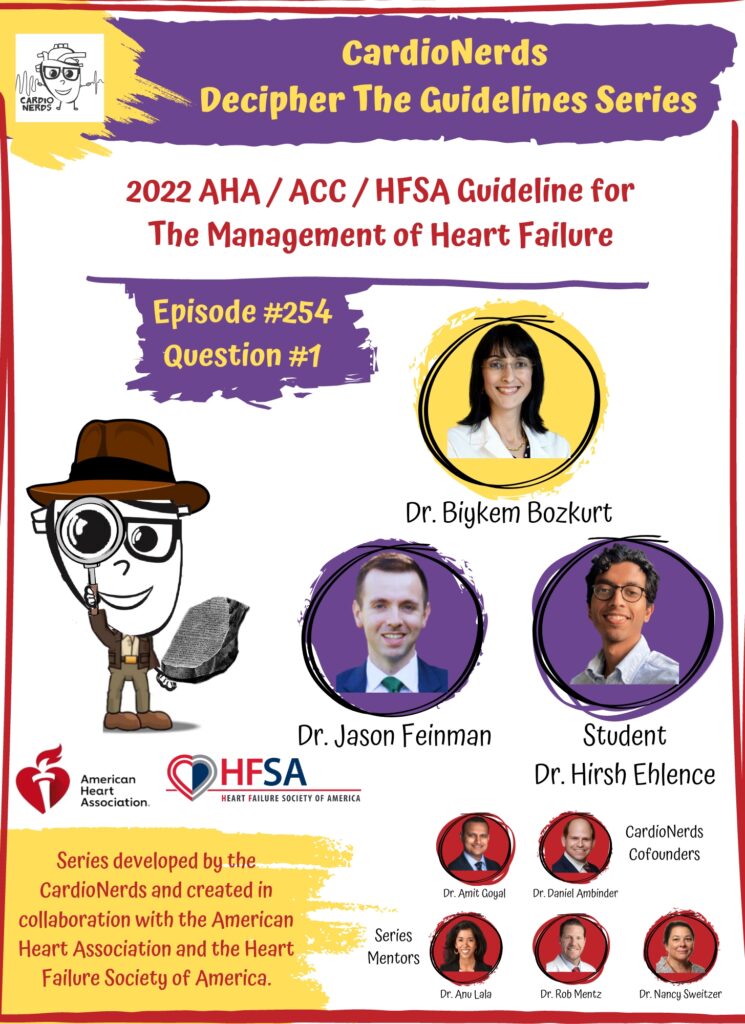Cardionerds: A Cardiology Podcast

254. Guidelines: 2022 AHA/ACC/HFSA Guideline for the Management of Heart Failure – Question #1 with Dr. Biykem Bozkurt
The following question refers to Section 2.1 of the 2022 AHA/ACC/HFSA Guideline for the Management of Heart Failure. The question is asked by Keck School of Medicine USC medical student & CardioNerds Intern Hirsh Elhence, answered first by Mount Sinai Hospital cardiology fellow and CardioNerds FIT Trialist Dr. Jason Feinman, and then by expert faculty Dr. Biykem Bozkurt.
Dr. Bozkurt is the Mary and Gordon Cain Chair, Professor of Medicine, Director of the Winters Center for Heart Failure Research, and an advanced heart failure and transplant cardiologist at Baylor College of Medicine in Houston, TX. She is former President of HFSA, former senior associate editor for Circulation, current Editor-In-Chief of JACC Heart Failure. Dr. Bozkurt was the Vice Chair of the writing committee for the 2022 Heart Failure Guidelines.
The Decipher the Guidelines: 2022 AHA / ACC / HFSA Guideline for The Management of Heart Failure series was developed by the CardioNerds and created in collaboration with the American Heart Association and the Heart Failure Society of America. It was created by 30 trainees spanning college through advanced fellowship under the leadership of CardioNerds Cofounders Dr. Amit Goyal and Dr. Dan Ambinder, with mentorship from Dr. Anu Lala, Dr. Robert Mentz, and Dr. Nancy Sweitzer. We thank Dr. Judy Bezanson and Dr. Elliott Antman for tremendous guidance.
A 23-year-old man presents to his primary care physician for an annual visit. His father was diagnosed with idiopathic cardiomyopathy at 40 years of age. His blood pressure in clinic is 146/90 mmHg. He is a personal trainer and exercises daily, including both weightlifting and cardio. He denies any anabolic steroid use. He is an active tobacco smoker, approximately ½ pack per day. Review of systems is negative for symptoms. What stage of heart failure most appropriately describes his current status?
A
Stage A
B
Stage B
C
Stage C
D
Stage D
E
None of the above
The correct answer is A – Stage A of heart failure.
Overall, the ACC/AHA stages of HF were designed to emphasize the development and progression of disease. More advanced stages and progression are associated with reduced survival.
Stage A HF is where patients are “at risk for HF”, but without current or previous symptoms or signs of HF, and without structural/functional heart disease or abnormal biomarkers. At-risk patients include those with hypertension, cardiovascular disease, diabetes, obesity, exposure to cardiotoxic agents, genetic variant for cardiomyopathy, or family history of cardiomyopathy.
Stage B HF is the “pre-heart failure” stage where patients are without current or previous symptoms or signs of HF but do have at least one of the following:
Structural heart disease (i.e., reduced left or right ventricular systolic function, ventricular hypertrophy, chamber enlargement, wall motion abnormalities, and valvular heart disease)
- Evidence of increased filling pressures
- Risk factors and increased natriuretic peptide levels or persistently elevated cardiac troponin in the absence of an alternate diagnosis
Stage C HF indicates symptomatic heart failure where patients have current or previous symptoms or signs of HF.
Stage D HF indicates advanced heart failure with marked HF symptoms that interfere with daily life and with recurrent hospitalizations despite attempts to optimize guideline-directed medical therapy.
Therapeutic interventions in each stage aim to modify risk factors (Stage A), treat risk and structural heart disease to prevent HF (stage B), and reduce symptoms, morbidity, and mortality (stages C and D).
Given this patient’s family and social histories, along with the clinical finding of elevated blood pressure, he is best classified as having Stage A, or at risk for HF. Were he to have signs of cardiac abnormalities on chest X-ray, ECG, biomarkers, or other testing, he would then be classified as having Stage B, or pre-heart failure.
Main Takeaway:
It is important to identify patients who are at risk for heart failure (Stage A HF) early to modify risk factors and prevent disease progression.
Guideline location:
Section 2.1, Figure 1, Table 3
Decipher the Guidelines: 2022 Heart Failure Guidelines Page
CardioNerds Episode Page
CardioNerds Academy
Cardionerds Healy Honor Roll
CardioNerds Journal Club
Subscribe to The Heartbeat Newsletter!
Check out CardioNerds SWAG!
Become a CardioNerds Patron!







 Visit Podcast Website
Visit Podcast Website RSS Podcast Feed
RSS Podcast Feed Subscribe
Subscribe
 Add to MyCast
Add to MyCast